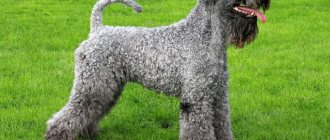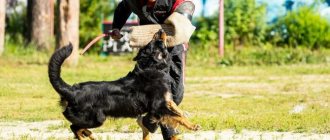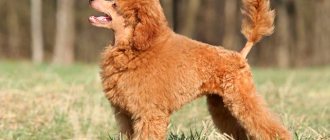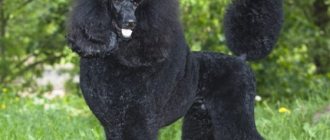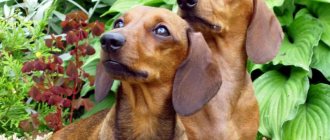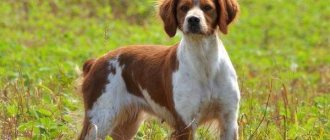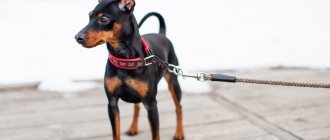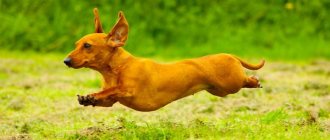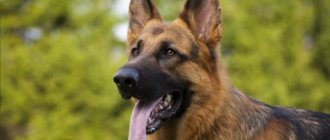Story
The Bull Terrier was bred at the beginning of the 19th century in England by crossing Dalmatians, white terriers and classic English bulldogs. The offspring of the then new breed often produced puppies with a characteristic appearance, but relatively small sizes. They were not rejected, and they immediately gained popularity among the population.
Interesting article: Varieties of bulldogs with photos and descriptions: all types of breeds
A miniature but strong, stocky and tenacious dog, it deftly hunted rodents and performed excellent security functions. However, the breeders decided to go further - they began to cross the babies with toy terriers, but the idea was unsuccessful. Animals began to lose external signs and acquired a lot of genetic abnormalities and diseases. The dogs were introduced to the public in 1914, but the breed was never registered.
The breeders were forced to return to the original version (the size of which was fixed by the genes of either Fox Terriers or Jack Russell Terriers). A club was opened in 1938, and in 1939 the country's canine community accepted the new breed.
The first exhibitions in England began only in 1963. World recognition came even later. In 1991, small bull terriers were evaluated in America and registered with the FCI.
They tried to create the first standard for dogs mixed with toy terriers, so the weight standards were very limited - up to 9 kg. But the variety did not take root, and the requirements were lifted.
Description
The animal looks harmonious and proportional. Requirements for weight - from 8 to 16 kg, for height at the withers - 25-35 cm. Weight is allowed a little higher, the main thing is to maintain compliance with the standard (and not due to obesity). The dog has an athletic build, well-developed muscles, and movements are characterized by speed and dexterity.
According to all descriptions of the breed, the differences between the mini bull terrier and the bull terrier are insignificant and consist only in size.
| Head | Body type |
| The skull has an oval, ovoid shape, the stop is not pronounced, and the forehead is flat. The muzzle is smooth, without obvious depressions | From the side, the dog looks square (that is, the height is equal to the length of the body). Massive body |
| The jaws are strong, massive, scissor bite, teeth are white and strong. The lips are wide and fit tightly to the gums. | The neck is long, with a slight bend |
| The nostrils are open well, the lobe is always black | The back is shortened, there is a slight convexity in the lumbar region |
| The ears are small with thin cartilage, cropped according to the breed standard | The chest is voluminous, deep, powerful |
| The eyes are small, triangular in shape, set obliquely. Color dark brown or black | The tail is set low, thickened towards the base |
| The belly is moderately adjusted |
Color
Different colors are allowed:
- white;
- ginger;
- spotted (with a clear predominance of white);
- brown;
- red;
- deer;
- brindle.
Snow White Bull Terriers may have colored markings on their heads.
Limbs
Short, muscular, set wide apart.
Wool
The skin tightly fits the body. There are no wrinkles or folds at all. The pile is short and hard, tight-fitting, shiny. During cold periods, a small soft undercoat is formed.
Breed description, standards and appearance
Minibull and ordinary representatives of this species are considered one breed. They have a beautifully built body and are quite proportional. Miniature dogs cannot be called dwarf bull terriers; they do not have this gene. There are several specific standards by which dogs of this breed are determined:
- Elongated head and flat skull.
- The eyes are triangular, slightly slanted, mostly dark in color, sometimes brown.
- The ears are close and erect.
- The nose is black.
- The upper jaw is weaker than the lower jaw, the bite is scissor-shaped, the teeth are white.
- The neck is quite muscular, powerful, and long.
- The belly is tucked in, the chest is wide and powerful.
- The back of the animal is quite wide.
- The paws are short, but powerful, mobile, and are parallel.
- The joints of the body are quite pronounced, the body itself is strong and powerful.
- The tail is straight and fairly short.
- There are no folds or wrinkles on the skin, the hair is short.
In principle, miniature and standard bull terriers are very similar, the only differences are in the parameters. The size of a small bull terrier does not exceed 35 centimeters; dogs weigh no more than 15 kilograms. In ordinary bull terriers, height can reach 50 cm, and weight is not limited at all.
Character traits
Dogs are distinguished by devotion and strong attachment to their owner. Despite their formidable reputation, minibulls are kind, cheerful, and love active games. They enjoy playing with children. However, at an early age, kids are a little jealous and can offend their “competitor”.
Expert opinion
Anna Abramenko
An avid dog lover. Experience in veterinary medicine since 2009.
Ask a Question
Minibulls are dominant towards pets and not very tolerant, especially towards other dogs. However, if pets grew up in company, they will even be friends with cats.
Dogs are not hostile with strangers and are even sociable and show curiosity. At the same time, they will always be ready if they feel that the owner is in danger. But excessive aggression is considered a defect in this breed. Such individuals are protected from society and sometimes euthanized.
Character and intelligence, attitude towards children and others
The character of the mini bull terrier is clearly choleric. The dog is extremely emotional, but at the same time balanced; all owners note its devotion and desire to stay close all the time.
The animal is characterized by energy and loves to play with children of preschool and primary school age. However, it is not advisable to buy such a puppy for families with newborn children: the bull terrier may become jealous.
These dogs will live peacefully with cats and other pets if they appeared in the house at the same time. In other cases, the bull will consider the cohabitants to be enemies and will be jealous when the owners begin to pay attention to them.
Descriptions of the Miniature Bull Terrier breed usually indicate that without proper education and training, animals grow up to be vicious. To prevent this vice from leading to serious trouble, the dog must be taught that it can only attack someone in case of danger, and in other cases it will be punished for showing aggression.
Education and training
You should start training your puppy immediately after purchase. A strong tendency towards dominance manifests itself at an early age, and it is important to immediately let the dog know who is in charge in the family.
Timely socialization of the pet is no less necessary. An ill-mannered minibull that is not accustomed to people will cause a lot of trouble and even become dangerous to others.
During training, dogs show their stubbornness and willfulness, which greatly complicates the process. Therefore, it is important to interest the baby while showing firmness and patience. The animal can easily master basic commands even under the guidance of an inexperienced dog breeder, as it has a high level of intelligence. But it is better to entrust serious training to a specialist dog handler.
This is interesting: 10 best fighting breeds
What needs to be instilled in a bull terrier from puppyhood:
- a clear understanding of who is the leader in the house and what the hierarchy is in the family;
- unconditional obedience is the basis for the safety of others;
- training is a mandatory, but positive and interesting procedure.
Expert opinion
Anna Abramenko
An avid dog lover. Experience in veterinary medicine since 2009.
Ask a Question
Dogs are sensitive to praise and positive emotions of the owner, and this greatly facilitates the educational process.
Why is a bull terrier dangerous?
Families with small children and those who are already frightened by stories about the “bloody exploits” of bull terriers are especially interested in this issue. Why is a bull terrier dangerous? Because it's a dog. Big, strong, fast. And it's not about the breed.
But there is no smoke without fire. There are several points due to which bull terriers have a reputation for being inadequate.
Willingness to fight to the end
Now everyone is saying that the Bull Terrier is a companion dog, and nothing more. This is true. But we must not forget that the bulls were forged in the crucible of dog fighting. In the past, they were forced to fight for their lives, with no way to retreat. This is unnatural to nature - usually, if a dog admits defeat in a fight, the winner does not finish off the defeated one.
Dog fights were often fought to the death. Therefore, a bull terrier cannot be defeated, it can only be killed. It is precisely because of their readiness to die or kill that boules emerge victorious in fights with dogs that are much larger than them in mass.
Please note - these dogs do NOT fight, but play with each other
Having made a decision, he will not back down
The famous stubbornness of bull terriers is their tendency to make decisions on their own. This is one of the few dogs that is more stubborn than dachshunds. It is this trait that makes it difficult or impossible to train a bull terrier to become a guard dog.
The shepherd will rush at the enemy after the command “face” or “take”, try to neutralize him and release him on the owner’s orders. Sometimes detained criminals do not even have bite marks left - the dog pushes the person with its paws and growls threateningly. If this is enough, she will not tear or bite the enemy.
This doesn't work with bull terriers. It is difficult to pull him away from the target, which a second ago he was ordered to “tear.” These dogs inflict serious bites, trying to kill, not neutralize. Dog trainers say that in the time it takes to train a bull terrier, I will raise three shepherd dogs.
The second point: the bull terrier begins to decide for himself which of those around him is a threat. And he may rush at an acquaintance who decided to jokingly pat you on the back, at a person who allegedly waved his hand.
A bull terrier cannot be trained to serve as a security guard. Fans of the breed never try to make a bodyguard out of a bully, especially since the dog’s menacing appearance is enough to scare off random hooligans.
Let me sleep, and you will protect me?
Aggression towards animals
Owners of bull terriers often face the problem of animal aggression - when a dog grows up, he may want to measure his strength with a larger opponent. Cats may also be at risk. The period from 6 months to 2 years is the most crucial in terms of dog socialization. A young bull must communicate with friendly relatives.
Any dog needs to be taught to live in society
The desire to play with a kitten as if it were a furry squeaky toy should be nipped in the bud. Most bull terriers easily get along with any pets in the same apartment. But some owners were unable to wean them from their passionate desire to chase cats.
All the bull terriers I know get along well with a cat in the same apartment
Like any other dog, a bull terrier should not be allowed to fight, and it makes sense to castrate males not involved in breeding.
You can read more about castration of male dogs HERE (link will open in a new tab).
Powerful physique
Bull Terriers are quite large dogs, reaching a weight of 30-35 kg, and sometimes 45 kg. At the same time, they have extremely powerful muscles. It is difficult even for an adult to hold a boule in a snatch. If it is necessary to pull the pet away, the owner may be in difficulty - the bull cannot be grabbed either by the cheeks, or by the ears, or by the fold of skin on the neck. They are perfectly smooth. Usually a dog in an extreme situation is restrained by grabbing its hind legs.
The Bull Terrier is as agile as a drop of mercury, heavy and not too delicate. All this leads to the fact that he can touch and butt people in a fit of joy. Therefore, it is better for elderly people and children to stay away from an angry dog. Personally, a bully broke my nose with his head while trying to lick my face. Even the bull terrier's tail flails like a club, and he wags it for any reason.
Care and maintenance
Due to its short fur, the animal is not too demanding to care for. For the same reason, it is recommended to keep minibulls not outside (in an enclosure), but in a house or apartment. They do not tolerate cold and severe temperature changes well. For winter walks, dogs are bought special overalls.
This is interesting: 10 scary dogs
Typical procedures:
- Once a week, the dog must be brushed with a stiff brush. This will cleanse her fur of loose hairs and dust.
- The claws usually grind down on their own. If not, then they need to be trimmed monthly.
- They bathe the animal with shampoo 3-4 times a year (whites a little more often). Dogs are very clean, so if necessary, it is enough to wipe them with a wet cloth.
- Teeth are brushed with toothpaste weekly.
- Once every 6-7 days you need to wipe the inside of your ears with a disk soaked in peroxide. At the same time, the shells are carefully inspected. To protect against infections, a prophylactic agent is instilled every month.
Deworming is carried out quarterly, and the skin is treated against ticks and fleas as necessary.
An important rule for keeping a minibull is daily long walks and physical activity. Up to 8 months, intensive exercise should be avoided, since the skeleton and ligaments are not yet strong, but later it is necessary to add thorough training in the form of jumping, outdoor games, and jogging.
Breeding miniature bull terriers
Dogs with aggressive episodes or genetic defects are not allowed to breed. The first estrus in females occurs at 6-16 months. However, it is undesirable to carry out mating during this period, since the body is not yet strong. Like males, it is best to breed them from the age of two.
Pregnancy lasts 58-65 days. The first time 3-4 puppies are born, the next time 5-7. It is better to limit the activity of a pregnant bitch. You should avoid active games and jumping from high surfaces. The diet must be varied with protein foods.
The first birth should be carried out with the help of a specialist. Without experience, it is difficult to adopt a litter without complications. If the female is very small, there is a risk of losing both the bitch and the offspring. Preparatory activities include providing the things necessary for the process: a box, clean diapers and napkins, scissors, a towel, a heating pad, threads.
In the last days of pregnancy, do not leave your pet alone. The desire for privacy, loss of appetite and apathy indicate that there are 2-3 days left before the birth. First, the dog starts having contractions, then pushing, after which the baby is taken out of the amniotic sac and the umbilical cord is cut.
Animals often do this on their own, but sometimes they may need help. Carefully remove the baby and wipe him with a diaper. If the umbilical cord is bleeding, it should be tied with thread. Give the puppy to its mother, make sure it finds the nipple. Sucking stimulates the contraction of the uterus and speeds up the process of the next baby.
Babies are born at intervals of 15-120 minutes. If the puppy is not born within this time, seek veterinary help. After the birth of each baby, the placenta comes out. If this does not happen within 60 hours, the pet may die. Therefore, it is necessary to count the number of afterbirths.
Nutrition
From 2 months, puppies are fed 5-6 times a day in small portions. As the year approaches, the number of meals is reduced to 2. To maintain your pet’s health, several recommendations should be followed:
- The easiest way is to feed your dog premium (or super premium) class dry food or holistic food, following the dosages indicated on the package.
- A natural diet requires careful attention. Minibulls are prone to overeating and obesity. The composition should include up to 80% protein (lean meat), some vegetables, fruits, cereals (buckwheat, oatmeal, rice), and herbs. Be sure to periodically give your dog vitamin supplements.
- Eliminate feeding from the common table, otherwise the animal will constantly beg.
- Follow a strict diet.
- Do not add sugar, flour products, smoked and pickled foods, or a lot of fat to your food.
To strengthen and clean your teeth, you can buy special bones at a pet store.
Advantages and disadvantages
Before getting such a dog, you need to pay attention to its positive and negative sides.
Advantages of the breed:
- determination and courage;
- devotion;
- energy;
- playfulness;
- high intelligence;
- ease of care;
- cleanliness.
Flaws:
- jealousy;
- tendency to dominate;
- stubbornness;
- cold intolerance.
Many negative character traits and skills of a minik can be corrected if you raise the dog correctly and in a timely manner.
Health and illness
Minibulls do not have good health. The most common diseases for this breed:
- congenital deafness (usually in white dogs);
- heart defects in various forms;
- displacement of the kneecap (accompanied by lameness and pain, gradually leading to arthritis);
- renal polycystic disease and dysplasia;
- dislocation of the lens (threat of blindness);
- tracheal hypoplasia;
- allergies;
- lethal acrodermatitis (begins due to a deficiency of zinc in the diet due to digestive characteristics, incurable).
Expert opinion
Anna Abramenko
An avid dog lover. Experience in veterinary medicine since 2009.
Ask a Question
Dogs must be periodically taken to the veterinarian for examinations, vaccinated on time, and at the slightest suspicious symptoms, seek advice from the clinic.
How much does it cost and where can I buy it?
Most health problems occur in white , and such a dog can get sick at any age and even from birth. White individuals often have hearing problems and various skin diseases. For this reason, white puppies are cheaper, and if a good healthy puppy can cost from 80 thousand rubles and above , then white babies are estimated on average 20-30 thousand rubles cheaper.
You can buy such dogs in many large nurseries, but not many specialists are involved in breeding mini bull terriers: due to the high cost, the breed is not very popular.
List of suitable nicknames
Even miniature bull terriers are serious dogs. They are characterized by a sharp mind, vigilance and stubbornness. This means that the name must correspond to these features.
The chosen nickname should immediately please the members of the family and be easy to pronounce, since it is not advisable to change it later once the pet gets used to it. The English origin and noble appearance of the dog allow you to choose the appropriate option among foreign names.
How to name a male dog:
- Arthur, Cupid, Agate, Archie, Baron, White, Gray;
- Elvis, Caesar, Zeus, Nike, Rocky, Charlie;
- Casper, Claude, Jack, Dick, Dani;
- Theo, Luke, Hulk, Cooper, Beck, Henry;
- Chuck, Chase, Jerry, Bond, King, Bruce, Mike, Perce, Oscar, Count;
- Uranus, Ice, Lion, Bike, Bob, Loki, Thor, Persian.
Nicknames for bitches:
- Astra, Bonnie, Molly, Jessie;
- Polly, Dina, Gina, Vesta, Tori, Greta;
- Vika, Lucy, Goldie, Rona, Alma;
- Busya, Fiona, Lily, Diana, Sherry, Zita;
- Irma, Sophie, Sonya, Laura, Keri, Maya;
- Cindy, Bella, Kara, Nyura, Kira;
- Chelsea, Lucky, Utah, Knopa;
- Percy, Ellie, Emmy, Taya; Yana, Zlata.
What is the breed for?
Alaskan Klee Kai (mini husky): description of the dog breed
Initially, the dwarf bull terrier was considered a good rat hunter, but now it is a fighting dog that takes part in dog fights. With good and proper upbringing, you can grow from her into a loyal friend, a devoted watchman.
The Mini Bull Terrier gets along well with children and other animals living in the house. Therefore, only the owner chooses how to raise a dog, a loyal friend or a fighting dog.
Differences between a Bull Terrier and a Miniature Bull Terrier
Rules for choosing puppies
When purchasing a pet, it is important to first research the characteristics and temperament of the breed. A small bull terrier should have a strong appearance, slight fatness, clean skin and correct proportions. Behavior is moderately active, cheerful, without aggression or excessive timidity.
The ideal age for a puppy is 2 months. All the necessary documents come with the dog.
Expert opinion
Anna Abramenko
An avid dog lover. Experience in veterinary medicine since 2009.
Ask a Question
Conscientious breeders and nurseries always monitor the nutrition and health of puppies and give vaccinations in a timely manner. When purchasing an animal, the future owner will receive detailed recommendations and advice from professionals.
Cheerful optimists who cannot stand loneliness
The Mini Bull Terrier is a brave, loyal and friendly creature.
The dog is constantly busy with active activities and loves to spend time playing with the owner and other family members. It is an ideal companion for people who love sports and travel. Being a sensitive friend with a fine mental organization, a small dog senses the change in the owner’s mood and tries to adapt to his daily routine. When communicating with a mini bull terrier, you should remember that any violent emotions, quick movements, even clapping your hands can become a signal for him to take active action and turn the dog into a hurricane, sweeping away everything in its path. The little bull terrier has a huge loving heart, which “bleeds” in the absence of the owner.
He cannot stand loneliness, so he is ready to follow the owner’s heels. Sometimes you have to lock your dog in an enclosure to find an hour to sleep. This breed is not suitable for busy people. Without communication, the “mini” bull terrier’s character deteriorates greatly, thereby the owner’s family will experience a lot of inconvenience.
A dog can spend more than one hour playing with small family members. However, children should not be left alone with a mini bull. If they begin to pull your pet by the ears or tail, push, or tease, he may feel threatened by them and bite hard. You can trust a dog of this breed to a child who has reached the age of seven to ten years. At first, it is advisable to control their communication.
Interesting facts from the life of dogs
Some interesting information about the breed for those who want to know more about it:
- Rats are very dangerous for cats and small dogs, as they desperately defend themselves when they feel a threat to their life. Minibulls hold the record for exterminating these rodents. Documented facts: one dog killed 100 rats in 5 and a half minutes, another killed 1000 in 100 minutes. This suggests that dogs have a low pain threshold and enormous physical capabilities.
- In the dashing 90s in Russia, the breed was popular for training individuals who were aggressive towards humans. Unfortunately, both varieties of Bull Terriers continue to have this bad reputation to this day.
- For amateurs in dog breeding, the word “bull terrier” has become a collective name for any dogs with smooth hair, a square muzzle and a massive body.
- The breed is one of the first in terms of the number of genetic diseases.
- The legislation of the USA and some other countries has developed a whole base of standards for owners of fighting dogs (which includes bull terriers). This includes insurance, large fines and various restrictions.
Expert opinion
Anna Abramenko
An avid dog lover. Experience in veterinary medicine since 2009.
Ask a Question
Before buying a puppy, a potential owner should carefully weigh his options for proper upbringing and timely socialization of the pet.
Price range
The cost of mini bull terriers is significantly higher than standard representatives of the breed, which is due to their scarcity and high customer demand.
The price is influenced by the prospects of the individual, heredity, exterior, age, gender and other factors.
On average, according to February 2021, a puppy that can only become a pet and a family favorite costs about 40-45 thousand rubles, but a puppy that has every chance of winning prizes at exhibitions and competitions can be buy for 65-75 thousand rubles.
Reviews
Our Butch is a very brutal dog and not at all difficult to keep. A stubborn character often manifests itself, but he is responsive to good treatment, so you can come to an agreement with him. He is a wonderful companion, active, cheerful. Ideal option for a family with children.
Despite the terrible reputation, they despaired of the little bull terrier. At first he turned out to be a kind-hearted puppy (though his character was noticeable from childhood), and now he has grown into a confident, cheerful and cheerful dog. His energy is inexhaustible, he has to walk a lot. Otherwise it does not create any difficulties.
Minibulls are kind and smart dogs, but they require serious training. They periodically show aggression, they need a firm hand and willpower. If the dog understands in time who is boss in the house, then there will be no problems later.
The Dwarf Bull Terrier is recommended for those who love fighting dogs, especially if living space is limited. However, such a pet is not suitable for every person, as it has a difficult and peculiar temperament. An owner with a strong character and a sensitive heart will be ideal for a minibull.
Temperament and behavior
Mini Bull is choleric. And in extreme cases. Any violent emotion of the owner, anger or joy, responds to the dog in a hyperbolic way. It immediately turns into a hurricane. The dog does not tolerate loneliness well; it needs the attention of family members. The behavioral characteristics of the breed are described in more detail below.
- With the owner. Dog owners are amazed by the loyalty and devotion of mini bulls. They become manically attached to a person. The dog is always nearby, trying not to lose sight of its owner even for a minute. It gets to the point that the pet has to be locked in a cage so that it can rest and not keep an eye on its owner. The companion is ready to support any adventure, regardless of the time of day.
- With kids. He loves children and enjoys playing with them. But you should not take a minik into a family where there is a very small child. The dog may consider the baby a competitor and offend him. Problems often arise when a baby appears in the house where an adult dog lives. Bulls are terribly jealous: it is difficult for them to understand why the owner’s attention is now directed to the baby. But as soon as you explain the rules to the dog and make friends with the child, they will become “indifferent.” An explanatory conversation will have to be carried out not only with the dog, but also with children: bulls do not like to be teased. If this is repeated constantly, the dog may even bite.
- With animals. A mini bull terrier will be friends with pets (cats, dogs) if it grew up with them. But animal communication needs to be supervised. Especially if two uncastrated males live under the same roof. The appearance of a new pet in the house often becomes a problem. The Bull Terrier is an owner; he may not allow other pets to approach his owner. When he meets dogs and cats on the street, he regards them as enemies: the call of blood makes itself felt. The fearless dog is ready to fight with brothers who are much larger and stronger than him. Due to the likelihood of fights, it is not recommended to let your pet off-leash in areas where there are a lot of dogs. Your pet needs to be taught to communicate with other animals on the street from early childhood.
- With strangers. These dogs are devoid of aggression towards people; they love to communicate. Viciousness is considered a breed defect: responsible breeders cull aggressive dogs. But if the pet feels that there is danger from a stranger, it will rush to protect its owner, because for him he is the center of the universe.
Bull Terriers sense their owner's mood. It is believed that they can empathize and sympathize. When the owner feels bad, the pet feels bad too.
Photo and video review
The best representatives of the breed are presented in our photo gallery. From the video review you can get a closer look at the behavior and temperament of animals.
Pros and cons of miniature bull terriers
Choosing a pet includes studying all the advantages and disadvantages inherent in a particular breed. Read reviews from dog owners in advance to make sure whether a certain type is right for you or not.
The advantages of miniature dogs include:
- Devotion;
- Playfulness;
- Bravery;
- Love for the owner;
- Hypoallergenic;
- Not difficult to care for.
Decorative dogs are interesting and funny animals. However, you need to find a personal approach to them. A family who loves active walks and leads a healthy lifestyle will easily make friends with a playful creature. Patient owners who put effort into raising their pet will find a faithful friend in the dog.
Among the disadvantages of the breed are:
- Stubbornness;
- Aggression towards other animals;
- The desire to be in charge;
- Excessive activity;
- Jealousy;
- The need for training;
- Sensitivity to temperature conditions;
- Congenital diseases.
Dogs are characterized by mental defects that are inherited. Therefore, the future owner should study all the pitfalls in order to be prepared for the difficulties associated with raising a pet. Finding out about all the disadvantages of the breed is an obligatory task of every responsible owner.
By temperament, dogs are real choleric. Any expression of the owner’s emotions, joy or anger, turns the four-legged dog into a hurricane. Excessive affection is expressed in obsession. Sometimes owners have to lock their pets in a cage at night in order to sleep peacefully. Animals can be jealous even of small children and push them away from their owner.
